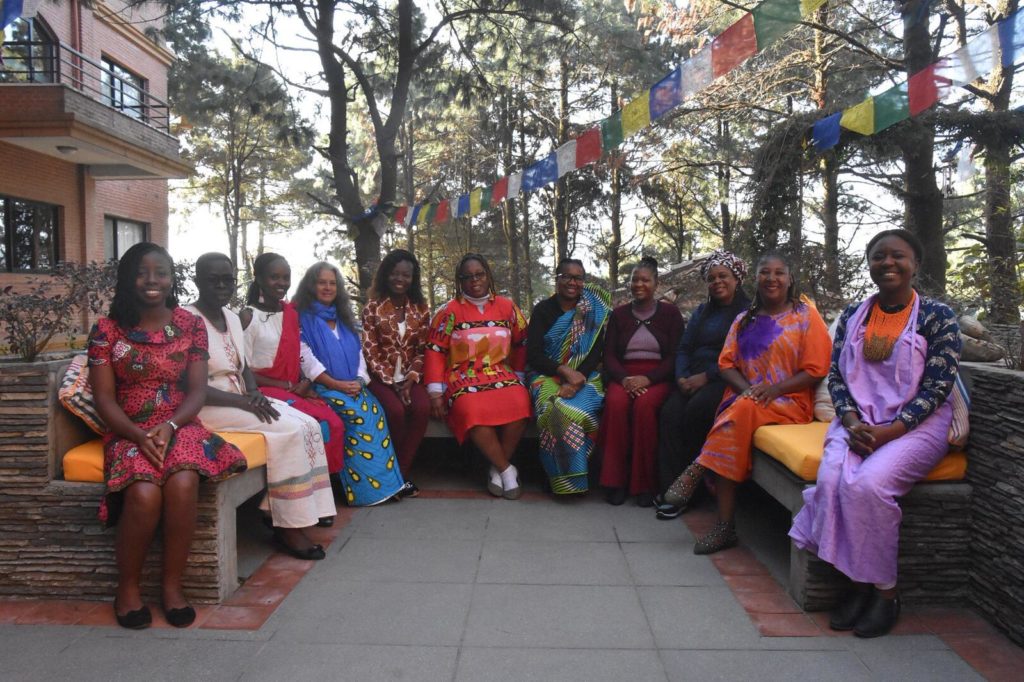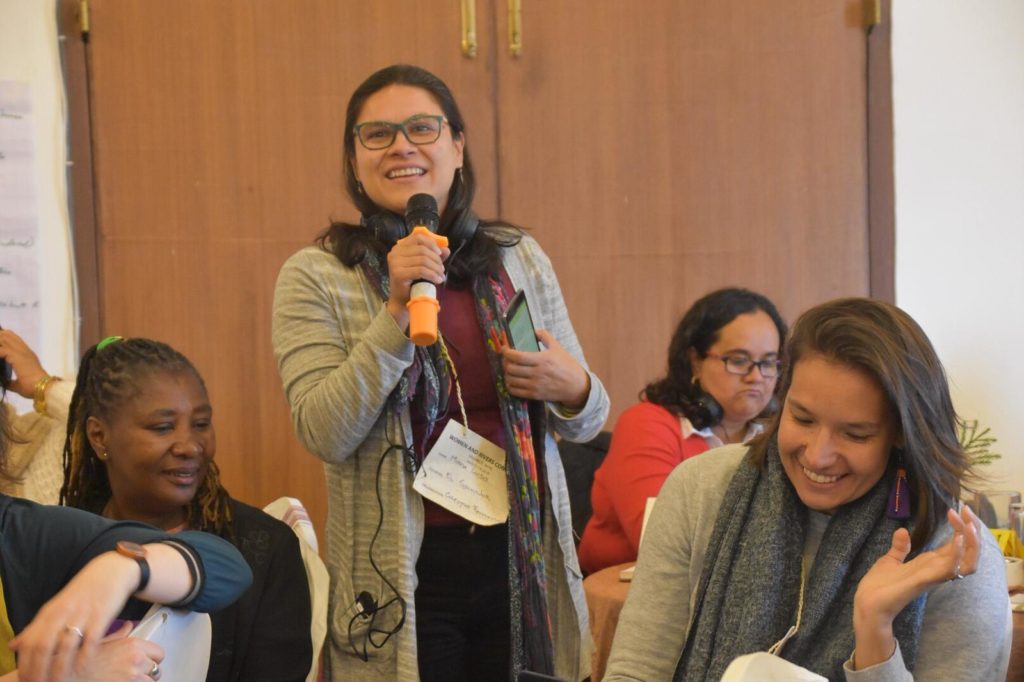By: Pai Deeetes, Thailand and Myanmar Campaigns Director
One word stood out on the screen, above all others: Stories.
It was the answer to a question posed on Day 1 of the first-ever Women & Rivers Congress, and it appeared above the crowd thanks to an interactive, real-time voting app. The question: What was your most important takeaway from the first day of the first-ever Women & Rivers Congress in Nepal?
The answer – “stories” – was a powerful reminder that women’s voices are often silenced and discounted, even in seemingly progressive settings.Women tell our stories at the 2019 Women & Rivers Congress.International Rivers
“A woman’s voice is rarely the first one heard at the table. When you have a panel at most events, even today, a woman’s voice is the token voice on a stage dominated by men.”
– South Asia Program Coordinator Ayesha D’Souza.

But for several days at the beginning of March in Nagarkot, Nepal, that was not the case.
Instead, nearly 100 women from more than 30 countries took center stage. International Rivers had conceived, organized and convened this meeting to celebrate the truth that women all over the world play a fundamental role in defending and stewarding freshwater resources – and to confront the fact that too often, women are excluded from the decision-making bodies and processes that affect their lives and rivers.
Transformative truth-telling
A meeting like this had rarely (if ever) been held before in Asia or anywhere else. But it was evident, soon after it began, that it was a transformative event, as women began forging connections and learning from each other.

You could feel the difference in the air. Despite the difficult subjects we discussed, the atmosphere outside the working groups was palpably light and positive; everyone seemed to have a smile on her face. The meetings, astonishingly, ran on time, with deep mutual respect evident between all the speakers. And the group was visually unlike any other conference, as women walked around in their colorful traditional clothes instead of the dour black suits that usually dominate such events.
But the differences ran deeper than that. I know from my work in Southeast Asia that cultural and gender barriers can silence women both in community meetings and at the government level and within corporations. In our few days in Nagarkot, activists who might traditionally have trouble speaking up gained experience and confidence as they told their stories to a rapt and attentive audience of other women.River defenders on the patio in Nagarkot, Nepal.International Rivers
One group of Lepcha activists, who were known for being reserved in organizing meetings in their home state of Sikkim, India, shared how communities have come together to protect the Teesta River, a tributary of the Brahmaputra. These courageous women deeply impressed the other participants, even across language barriers, and they revealed an outgoing, talkative side that contrasted sharply with their demeanor in mixed or male-dominated settings.

This was no minor achievement. Just 7% of water and natural resources ministers are women, and women are deeply under-represented in the private and financial sectors, which frequently make investment decisions that affect rivers and river communities. There’s only one way to confront this asymmetrical power dynamic: by elevating and empowering women leaders.
Empowering women leaders means, in part, forging connections. This was the first time many of the grassroots activists from frontline communities had been in the same room with academics, journalists, lawyers and funders whom they would never encounter otherwise. These kinds of connections, so firmly established in male power structures, are at an early stage for women activists, and it was encouraging to see them finally taking shape.

In turn, the attending funders, journalists, lawyers and academics gained an invaluable opportunity to hear the unvarnished truth on the ground for many frontline communities.
A significant setting
The Himalayan ranges near Nagarkot, Nepal.International Rivers
It was no accident that we held the Congress in Nagarkot, a village situated at the rim of the Kathmandu Valley with views of eight Himalayan mountain ranges. The mountains are ablaze every night at sunset and every morning at sunrise. We wanted a place where participants could reflect and relax, and this stunning location, with its clean mountain air and lack of distraction, fit the bill.
But the view was more than just pretty: The Himalayas are also the source of at least ten life-sustaining transboundary rivers in Asia, including the Nu/Salween. We had come back to the source – the source of life for so many countries downstream, a source of life so deeply threatened now by climate change and development.

A group of activists working across boundaries between China and Myanmar to protect the Nu Jiang/Salween River encountered each other for the first time in years here, near the river’s headwaters. Wang Yong Chen, one of China’s most prominent environmental journalists and the one person largely responsible for the Chinese government’s shelving plans for a 13-dam cascade in 2016, rushed towards me and hugged me hard.
She gave me a thick book with text and pictures about the river that lives in both of our hearts. “I am really proud that our beloved river still flows freely – one of the few in the world. It’s because we never give up,” she said.
She persisted
On the second day, we asked participants what they took away from the “Our Roles as Women Leaders” plenary session. The top answer? Persistence.Participants share their stories at the 2019 Women & Rivers Congress in Nagarkot, Nepal.International Rivers
It’s a necessary quality in the face of entrenched patriarchal systems that often use violence to protect their power. In Latin America, Liliana Avila Garcia of AIDA said, women who work “to protect the rights of communities and resources, including rivers, forests and lands, we risk our lives. Many of our colleagues are threatened. Some people are dead. But…we have to fight.” Her sentiments were shared by colleagues from many other regions.

Some leaders are working to preemptively protect their rivers. At one point, Maureen Harris, our Southeast Asia Program Director, was deep in conversation with lawyers from Thailand, China, and India, as well as law professors, in a corner of the bar, hashing out legal channels to support river protection.
There was a clear appetite for follow-up events. Participants reported feeling more connected to each other and the movement each day, and they were hungry to dive deeper into certain topics, including movement building, water tenure and collective leadership. Three-quarters said the Congress helped them extend their networks – and that they wanted more. In response, we’ve established a listserve and transformed the Congress website into an information hub – but we know more is needed.
What’s next?
The threats to our rivers and the women who steward them are real. But the value of this gathering was real, too. We hope that participants took inspiration, courage and tools away from the gathering, while also recognizing the need for more connection and leadership development. We see the Congress as a meaningful first step as we pursue a new kind of organizing model that puts women exactly where they belong: front and center.
“It’s very unusual to find a conference dominated by women,” said Manju Vasudevan of South India’s River Research Centre. “Each woman represents a whole struggle and a whole lifetime of having worked for something. All of them are so passionate.” She took a moment before continuing. “It’s actually very overwhelming,” she said, “and it’s beautiful.”
Read the Nagarkot Statement!
Featured image: Woman & Rivers congress group photo | Photo by International Rivers

